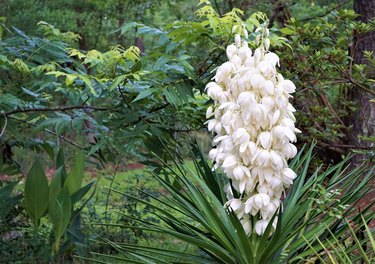
Yucca plants (Yucca spp.) thrive in full sun and sandy soil and do well in times of drought and heat. Hardy in U.S. Department of Agriculture zones 5-10, depending on the species, they rarely suffer from pests and disease in these growing conditions, but when conditions are too wet for the plant, you may find black or brown spots on yucca leaves showing a fungal infection. The first step in the treatment of yucca is the identification of the fungus.
Black Spots on Yucca Leaves
Video of the Day
There are several fungi that may cause leaf spot disease on your yucca plants. Brown leaf spot, caused by Coniothyrium concentricum, starts out as clear spots that darken to yellow and then brown. Coniothyrium bartholomaei causes dark purple spots and the center of these spots will eventually lighten into a grey color. If your yucca plant has black spots, this can occur as the disease progresses, and black fruiting bodies, or perithecia, develop in the lesions.
Video of the Day
Cytosporina spp. can cause grey leaf spot on Spanish-bayonet (Yucca aloifolia, USDA zones 8-11) which causes lesions with rings of dark and light coloring. Other leaf spot causing fungi that may infect yuccas include Cladosporium herbarum, Kellermania yuccifolia and Phaeosphaeriopsis obtusispora.
Unfortunately, once a yucca leaf is infected with leaf spot, there is no cure for the disease. That doesn't mean your yucca is doomed, however. Simply remove and discard the infected leaves. Take care not to leave any infected material on the ground and do not compost infected plant leaves. Apply a fungicide, such as a copper fungicide, to the healthy tissue to prevent leaf spot on the new leaves.
Other Fungal Infections
Stem rot caused by Fusarium spp. fungi is another infection you may see in wet conditions, especially on young yucca cuttings. The rotted stems will eventually kill the attached leaves. You may see bright red fruiting bodies of the fungus. Remove infected cuttings so that the infection doesn't spread to nearby plants.
Southern blight, caused by Sclerotium rolfsii, can attack any part of your yucca plant and is often fatal. You may see fungal growth growing in a fan pattern near the soil surface and water-soaked lesions on the stems and leaves.
Remove and discard any plants infected with southern blight. Since the fungus lives in the soil, remove the surrounding soil as well. Select a plant that is resistant to the fungus to grow in that location in your garden for a few years. You can apply a fungicide labeled for use against southern blight, but these aren't always effective.
Prevent Fungal Infections
The best way to deal with fungal infections is to prevent an infection. Make sure your yucca has loose, well-draining soil and a location with full sun. Consider thinning your garden if necessary. A lack of airflow from an overcrowded garden bed can increase the risk of infection. If you need to provide supplemental irrigation, opt for drip irrigation to keep the yucca's leaves dry.
Make sure you disinfect all of your gardening tools so that you don't spread the infection around your garden. Wipe the blades with a household disinfectant such as Lysol or soak the tools in a 10 percent bleach solution for about 30 minutes.
- University of Florida IFAS Extension: Yucca Production Guide; R.T. Poole, et al.
- University of Florida IFAS Extension: Yucca
- Pacific Northwest Pest Management Handbooks: Yucca-Leaf Spot
- University of Florida IFAS Extension: Disinfecting Your Garden Tools
- University of Minnesota Extension: Fusarium Crown and Root Rot
- University of Wisconsin-Madison: Southern Blight